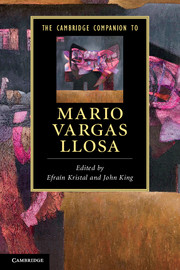Book contents
- Frontmatter
- Introduction
- 1 Reality and rebellion: An overview of Mario Vargas Llosa’s literary themes
- 2 The early novels: The Time of the Hero and The Green House
- 3 The total novel and the novella: Conversation in The Cathedral and The Cubs
- 4 Humour and irony: Captain Pantoja and the Special Service and Aunt Julia and the Scriptwriter
- 5 The historical novel: The War of the End of the World
- 6 Innocence and corruption: Who Killed Palomino Molero? and The Storyteller
- 7 The political novels: The Real Life of Alejandro Mayta and Death in the Andes
- 8 The erotic novels: In Praise of the Stepmother and The Notebooks of Don Rigoberto
- 9 The dictator novel: The Feast of the Goat
- 10 From utopia to reconciliation: The Way to Paradise, The Bad Girl and The Dream of the Celt
- 11 The essays
- 12 The memoir: A Fish in the Water
- 13 The plays
- 14 Film and the novels
- 15 An interview
- Further reading
- General index
- Index of selected fictional characters
- Index of selected works by Vargas Llosa
6 - Innocence and corruption: Who Killed Palomino Molero? and The Storyteller
Published online by Cambridge University Press: 28 January 2012
- Frontmatter
- Introduction
- 1 Reality and rebellion: An overview of Mario Vargas Llosa’s literary themes
- 2 The early novels: The Time of the Hero and The Green House
- 3 The total novel and the novella: Conversation in The Cathedral and The Cubs
- 4 Humour and irony: Captain Pantoja and the Special Service and Aunt Julia and the Scriptwriter
- 5 The historical novel: The War of the End of the World
- 6 Innocence and corruption: Who Killed Palomino Molero? and The Storyteller
- 7 The political novels: The Real Life of Alejandro Mayta and Death in the Andes
- 8 The erotic novels: In Praise of the Stepmother and The Notebooks of Don Rigoberto
- 9 The dictator novel: The Feast of the Goat
- 10 From utopia to reconciliation: The Way to Paradise, The Bad Girl and The Dream of the Celt
- 11 The essays
- 12 The memoir: A Fish in the Water
- 13 The plays
- 14 Film and the novels
- 15 An interview
- Further reading
- General index
- Index of selected fictional characters
- Index of selected works by Vargas Llosa
Summary
Published within one year of each other, Who Killed Palomino Molero? (¿Quién mató a Palomino Molero?, 1986) and The Storyteller (El hablador, 1987) are superficially very different, the former focusing on a melodramatic small town murder mystery, and the latter delving into the myths and cosmology of a Peruvian Amazonian tribe, the Machiguenga. The town of Talara in northern Peru links the two stories, in that it is the scene of the murder of Palomino Molero and is the home town of Saúl Zuratas's mother in The Storyteller. Both novels have an identifiable biographical point of origin; Palomino stems from Vargas Llosa's involvement in the 1983 Uchuraccay Investigatory Commission, set up after the murder of eight journalists, and The Storyteller harks back to Vargas Llosa's visit in the mid-1950s to the Alto Marañón region of the Peruvian Amazon, which sparked his long-lasting engagement with the debate about the place of indigenous cultures in a modern, Westernised society. They have in common a concern with the problematic nature of concepts such as ‘truth’ and ‘authenticity’ within the context of specific racial and social tensions.
Who Killed Palomino Molero?
Who Killed Palomino Molero? is, as its title proclaims, a self-conscious detective-style narrative; for the setting Vargas Llosa returns to Talara in the 1950s, and to his ‘two most recurrent characters’, Lituma and Silva. The two policemen are seeking to solve the mystery of the horrific mutilation and hanging of a young bolero singer from Piura, Peru, recently enlisted in the air force.
- Type
- Chapter
- Information
- The Cambridge Companion to Mario Vargas Llosa , pp. 74 - 87Publisher: Cambridge University PressPrint publication year: 2011



